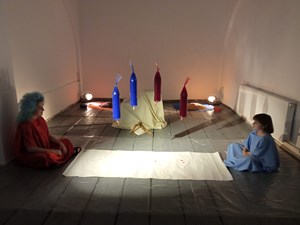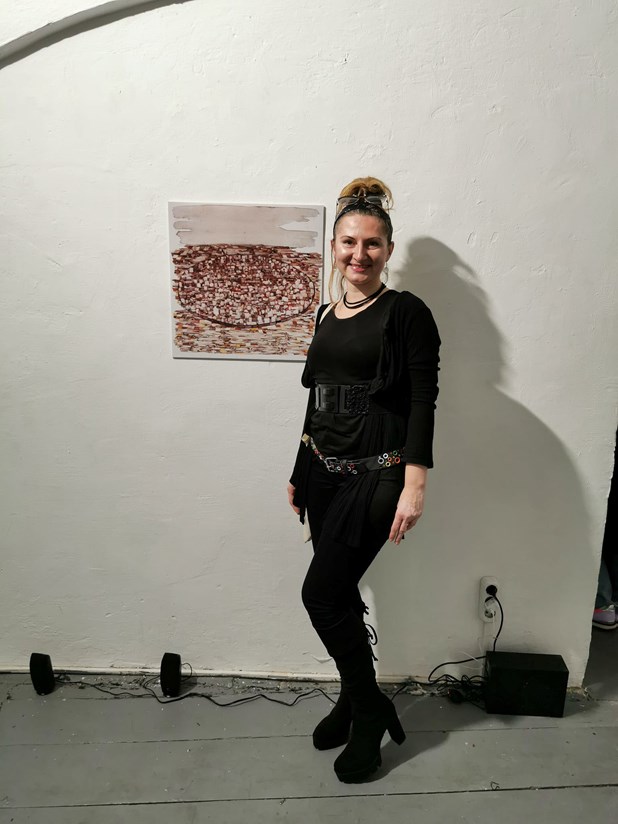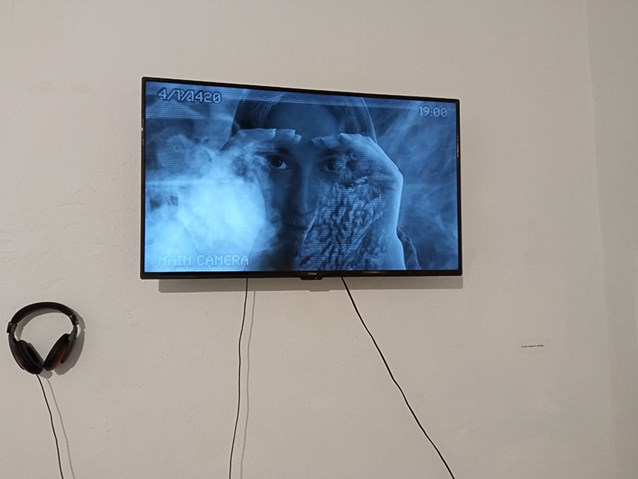
Happiness is in a connection and compassion with others, as a source of hope, empathy, accountability, and authenticity. The real purpose of art is to communicate a feeling. The global experience of the covid 19 pandemic has caused changes in the way society function: working from home, online teaching, meetings on various internet platforms, so establishing interpersonal relationships as "another way(s) of communication" is a challenge.
Happiness is in a connection and compassion with others, as a source of hope, empathy, accountability, and authenticity. The real purpose of art is to communicate a feeling. The global experience of the covid 19 pandemic has caused changes in the way society function: working from home, online teaching, meetings on various internet platforms, so establishing interpersonal relationships as "another way(s) of communication" is a challenge.
Conceived by Isidora Fićović, in partnership with Selda Asal and Apartment project Berlin, the exhibition includes artists from Belgrade and Berlin, who examine human relationship to the body, as its most immediate nature, through their artworks and dialogue, and that relationship speaks of human relationship to nature. The development of the senses and ecological awareness improves the environment, but also aims to establish empathic interpersonal relationships, sociability and culture. The language of contemporary art is a field of re-examining "another way(s) of communication" with the use of different human senses, tactility, manual work, bodily gestural free movement in space, overcoming the limited gesture of typing on a mobile phone screen or computer keyboard, where conversation with others is limited to the sense of sight and hearing.
 "0"-grad, Watercolor, 50X50 cm (The work is accompanied by an album called "A walk in the "0"-grad". The album suggests an imaginary soundscape designed for the impossible city “0-grad” using location recordings and modular synthesisers), Melih Sarigöl, 2019
"0"-grad, Watercolor, 50X50 cm (The work is accompanied by an album called "A walk in the "0"-grad". The album suggests an imaginary soundscape designed for the impossible city “0-grad” using location recordings and modular synthesisers), Melih Sarigöl, 2019
The exhibition in Ostavinska Gallery in Belgrade, which took place from November 19th - 25th of November 2021 and will take place again in January 2022 at Apartment Project in Berlin.
Presenting artists include Merey Şenokak, Melih Sarigöl, Funke Collective Berlin, Emre Birişmen, Snežana Arnautović, Marijana Oro, Marko Nektan, Ana Cvejić, Magda Radojlović.
The title of the project "Another ways of communication" is written with an error. A grammatically correct sentence would be 'Other ways of communication', or 'Another way of communication', but the title has been written intentionally as "Another way(s) of communication", since it's highlighting the notion of an error. If we think about the meaning and purpose of an error, concerning the language of the machine or the language of human, what makes a difference in between these languages, if there is an error:
For example, if human language and code used for computational algorithmic language are observed analytically, it will be observed that "human languages are ambiguous and contain large vocabularies", while "code is a strict syntactical rule of small vocabulary." The other thing is that "computers are not able to interact meaningfully if it is not stated precisely. In every language there are rules of grammar, but if a word or two are misspelled, still it is humanly possible to understand but a computer doesn't have this potential." (FORM+CODE In Design, Art, and Architecture by Case Reas, Chandler McWilliams, and LUST, 15).
 Crystal Rose, Acrylic and ink on canvas, 40x40 cm, Marijana Oro, 2021
Crystal Rose, Acrylic and ink on canvas, 40x40 cm, Marijana Oro, 2021
Error can be a trigger in learning process, going beyond, exploring unfamiliar, expending the horizon, error as an exception and originality in the process of creation, how error makes us learn.
Thinking of the notion of an error as part of a learning process, maybe it could be applied to how, why, what, in which way, the manual art work you are producing, bodily sensing, makes a difference to the technological developments of new media tools, devices and gadgets, use of new technological devices on a daily basis, what makes a difference if we turn to our bodies and its potentials, variety of senses. What means to be human in current technologically oriented society, online learning, what makes a difference, what could be "Another way(s) of communication" maybe the notion of an error could be a leading path, to see it brighter or clearer how digitalization can be humanized, keeping it in mind the physicality, body movement, free style gestures, manual, tactile shaping of creative artistic processes, real time and space etc.
 FUNKE, Video, 2’48’’, Funke Collective Berlin, 2020
FUNKE, Video, 2’48’’, Funke Collective Berlin, 2020
Isidora Fićović graduated from the painting department at the Faculty of Fine Arts in Belgrade, MA and Magister of painting diploma (2001, 2007). Through the completed master studies, Master of Arts diploma, at the Interface Culture in Linz, Austria (2016), she expanded her artistic and creative work to interactive art and interdisciplinary understanding of the work itself. Visiting student at IAMAS [Institute of Advanced Media Arts and Sciences] in Ogaki, Japan (2015-2016); Erasmus exchange to Bilgi University (Visual Communication Design department, VCD) in Istanbul, Turkey (2013-2014). Since 2001 exhibited in numerous solo and group exhibitions, festivals and biennials in Serbia, Austria, Turkey, Italy, USA, Denmark, Sweden, Switzerland, Germany, England, Slovenia, Ukraine, Japan and so on. She won the Rotary club award for painting in Belgrade (2017, 2012), first prize at the video festival in Velenje, Slovenia (2005). Her works are in the collection of Cultural center Despotovac, Cultural center Kovin, Lucida Gallery, XVitamin Gallery, Cultural Center Leskovac, and Center for visual education Šumatovačka in Belgrade, Platform Garanti and Apartment project in Istanbul, as well as in private collections. She has exhibited at Ars Electronica festival, POST CITY (2015) and Total Recall (2013). PhD at the Faculty of Fine Arts, Belgrade (2021).

ArtDependence Magazine is an international magazine covering all spheres of contemporary art, as well as modern and classical art.
ArtDependence features the latest art news, highlighting interviews with today’s most influential artists, galleries, curators, collectors, fair directors and individuals at the axis of the arts.
The magazine also covers series of articles and reviews on critical art events, new publications and other foremost happenings in the art world.
If you would like to submit events or editorial content to ArtDependence Magazine, please feel free to reach the magazine via the contact page.